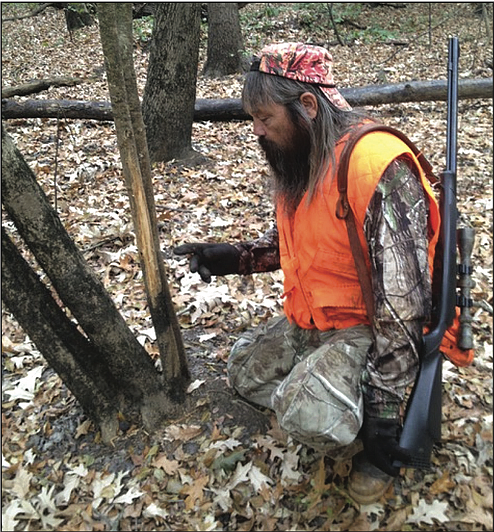Deer hunting is synonymous with fall, and many new hunters wonder how to enjoy a sport that seems mysterious and inaccessible.
Access is the easy part. Observation erases the mystery.
In Arkansas, hunters have access to about 3 million acres of national forest land, mostly in the Ozark and Ouachita national forests. They encompass about 1.5 million acres each. The St. Francis National Forest in eastern Arkansas offers more limited deer hunting access and is best suited to bowhunting.
I have spent a lot of time hunting in the Ozark National Forest, especially in the Hurricane Creek Wilderness Area and also in the vicinity of Big Piney Creek and Little Piney Creek. The habitat is steep and rocky, but the oak/hickory forest provides a lot of food in a good year of acorn production. I have introduced several new sportsmen to deer hunting in these areas. Deer are plentiful, and some of my novice friends have killed respectable bucks.
In addition, excellent deer hunting is available on several national wildlife refuges. The White River National Wildlife Refuge is the largest. To the north is the Cache River National Wildlife Refuge. Together, these form a vast north-south swath through some of the state's most productive wildlife habitat. Wapanocca National Wildlife Refuge (5,484 acres) in Crittenden County is an overlooked deer hunting opportunity, as is Bald Knob Wildlife Refuge (15,022 acres) in White County.
The best known and most popular deer hunting opportunities are on the wildlife management areas that the Arkansas Game and Fish Commission owns or manages cooperatively with other public and private landowners. The Game and Fish Commission limits deer hunting pressure on some wildlife management areas by issuing small numbers of permits for hunting with muzzleloading firearms and modern firearms. However, bowhunting access on these areas is unregulated.
Also, there are a lot of other wildlife management areas where deer hunting with firearms is unregulated. Two that come to mind are Howard Hensley Wildlife Management Area in Searcy County and Loafer's Glory Wildlife Management Area in Marion County.
With so many places to hunt, where should you go? Pick a place close to home or in a region you enjoy. I like to hunt in the Ozarks, so I gravitate to public land in that region.
Learn your area. Specifically, learn a few areas within the area, and become as familiar with those micro-locations as you are with your own home. My favorite public hunting area is Madison County Wildlife Management Area. I am fortunate to draw controlled hunt permits fairly frequently for muzzleloader or modern gun hunts. Sometimes I draw permits for both hunts.
Madison County WMA is a large area containing two large units. Both units have multiple personalities. When I first started hunting there, I studied a map and found an area far from a road. Most hunters don't venture far from roads. If you walk far enough, you will not see any other hunters.
Chances are that your first visit to an area will be during a hunt, so you will not have had time to formulate a hunting strategy. That is not a guaranteed liability. Having written deer hunting articles for 30 years, I know that a great many hunters kill deer during their first visits to an area. Several have killed Boone and Crockett bucks. While that is not and should not be a priority for a novice deer hunter, it does illustrate the possibilities.
Move slowly and take mental pictures of everything. You will see deer trails through thickets and woods. A trail means a lot of deer take that path regularly. A trail always goes somewhere. Most likely it connects refuge cover with a feeding area. Look for intersecting trails because that's a convergence point where you have an opportunity to see deer coming from multiple directions.
If you find food, you will eventually see deer. In October and early November, look for white oak trees that are dropping acorns. White oak acorns are sweeter than red oak acorns, and they are like candy to deer. If a tree or a cluster of trees is loaded and dropping acorns, deer will be there at some point in the day to eat them. The most dependable times are at dawn and dusk, but deer often feed from 11 a.m. to 1 p.m., as well.
Look for soft mast such as ripe persimmons, muscadines and berries because deer love them.
Also, pay close attention to signs of rutting activity. The rut is the whitetailed deer's breeding season. October is the pre-rut period in most of Arkansas. You will notice small trees with the bark rubbed off at knee height. These are called "rubs." Bucks rub their antlers on trees to remove velvet, but also to mark territory. A buck doesn't visit a rub on a timetable. Sometimes he doesn't visit for days. The chances of encountering a buck at a rub are low, but a rub does indicate that a buck travels frequently in that area.
You also will see places scraped clean of leaves, usually under a low-hanging branch. These are called scrapes. Deer paw at and urinate on scrapes, and they rub their scent glands on the low-hanging branches. These are like information kiosks where deer leave their calling cards, and it lets a buck know that does in estrous are present.
Find a comfortable place to sit that overlooks an approach route to a place where your observations suggest you should see a deer and wait.
You might not have to wait long.
